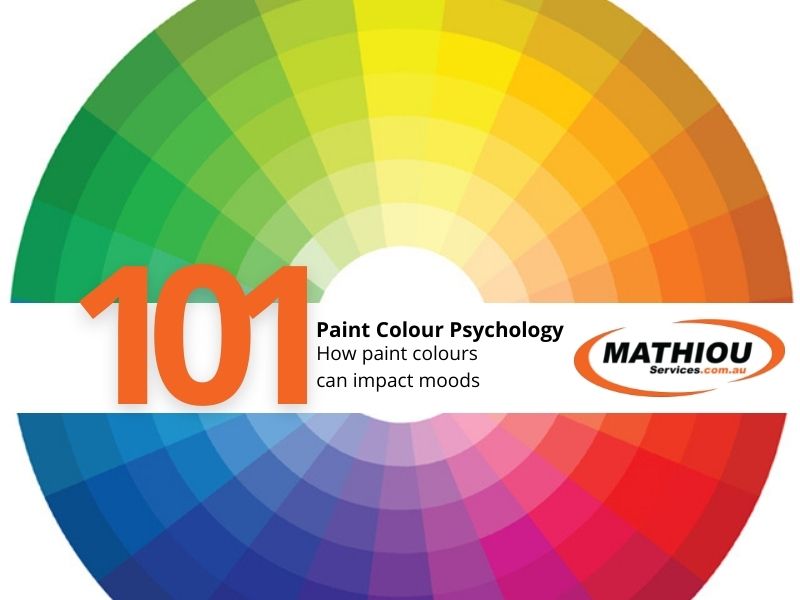Paint Colour Psychology is often overlooked when choosing an internal or external paint colour scheme and yet it can be the catalyst that evokes an emotion or mood in a room or play area. Choices are proven to change depending on the mood of the person who is making that decision, so it pays to look at it collectively as opposed to having one person make the choice depending on the use of the paint colour. Understanding these effects helps in designing spaces and products that elicit desired reactions from people, whether to relax, attract attention, or convey a particular message.
Here are a few tips on how to choose colours for your internal or external painting:
- Warm vs. cool colours – When using colours in a room try to use a combination of both warm and cool colours to balance it out. You can have warm neutral tones with cool colours or a cool neutral tone to go with a warm colour (See below about warm, cold and neutral tones)
- Darker colours have a tendency to close in a room so they make a small space look really small. This is great for an intimate setting but not great if you are wanting to create a sense of space. Balance it out with a neutral tone.
- Match the colour to the room’s needs – Before making a choice, make sure that the psychological impact of the colour is in line with the emotions you are trying to evoke. It wouldn’t be a great idea to put a loud colour that creates excitement in a childcare room where you would like toddlers or kids to be calm or sleep. Likewise, putting the colour red which is known for raising blood pressure in a medical clinic wouldn’t be ideal either. You can read more on the psychological impact of colours below.
- Consistency – whether this is used in a commercial property or in a home, pick one consistent paint colour to use throughout the property. Normally this is a neutral tone, but some companies often choose the feature colour as the constant. Regardless, once you choose a contrasting colour that would be your feature make sure this colour is interchangeable throughout your property. For example, if you’re choosing to have one feature colour, a black feature wall won’t necessarily work in all rooms.
- Choose a colour that reflects your brand style or companies’ character – have you got a primary brand colour, would it work as the “consistent” colour throughout your property or would it be better off used on accents throughout your property.
Warm vs. Cold vs. Neutral Coloured Paint tones
When you think of warm tones, think of the colour of the sun or fire like your yellow’s, reds and oranges or various shades like these. These warm tones often have a strong stimulation from calm to extreme passion.
Cool colours like your blues, greens and light purples can create a calm and soothing effect.
Your neutral colours are from the monochrome scale of black to white, but most paint decorators also include your beige (light brown) colour tones as well. While whites are great to brighten a space, blacks make it feel smaller. The in-between of the scale and even your beige are considered colours to help neutralise a room and compliment your warm or cold tones.

Here are a few tips on how each colour impacts you psychologically and emotionally:
The psychological impact of the colour red
- Is a bold, vibrant warm colour.
- It evokes the strongest emotions of all colours from passion, excitement (bright red), energy, action and desire (lighter red). Because of this, it represents those stronger emotions we feel like love, rage, and is the universal STOP/danger colour. It is often used in these settings for example red sirens or stop signs.
- Food & beverage brands like McDonalds, KFC, Coca-Cola also use it. Research has shown the colour red increases blood flow, when the blood flow increases it increases your heart rate and metabolism which stimulates hunger (12).
The psychological impact of the colour Blue
- Known to evoke a calm and a relaxing environment.
- It can make you feel centred, relaxed and serene.
- Different shades of the colour blue represent intelligence, Trust, honesty, power, and serenity. (12)
- Studies show warm blues lower blood pressure while slowing your respiration and heart rate.
- Warm blues are often chosen for classrooms with kids that have tantrums or show aggressive behaviour (4).
- Research shows that the colour blue can act as food suppressant so is not recommended for a kitchen or dining room (13).
The psychological impact of the colour Green
- Represents nature and tranquillity.
- It is known to evoke a relaxing feeling, warmth and togetherness (8).
- Studies show that when used indoors it reduces anxiety & stress.
- Emotionally triggers the feeling of hope, growth, refreshing, balance and reassurance(12)
- Some studies and cultures link green to success which creates a sense of motivation.
The psychological impact of the colour Yellow
- Is seen as a friendly, joyful, lively and warm colour.
- It tends to brighten your mood and increase your energy (6).
- Yellow is known to stimulate memory and hunger (7).
The psychological impact of the colour orange
- Known to evoke the feeling of fun, high energy and enthusiasm.
- Represents optimism, enthusiasm, uplifting, rejuvenating, fun.
- Often used to increase energy levels in a room.
The psychological impact of the colour Purple/Indigo
- Represents power, nobility, luxury, wisdom, and spirituality.
- Indigo = mystery, imagination, wealth and royalty.
- Lighter purples evoke relaxation like lavender.
The psychological impact of the colour Brown
- Through its connection to wood and earth, brown is associated with reliability, dependability, and nurturing.
- The darker shade can however have a feeling of loneliness and sadness when too much is used.
- Whereas the lighter browns are to soil and timber, Earths natural elements have a soothing and calming effect.
The psychological impact of the colour Grey
- Represents neutrality and balance (9).
- Brings comfort and warmth.
- It’s completely versatile.
- Timeless and classic in lighter shades.
- Edgy and modern in darker hues. (10)
The psychological impact of the colour Black
- Black has both positive and negative feelings associated.
- Represents exclusivity, prestige, power and luxury.
- Often used in theatres or rooms to create a sense of mystery and depth and to create a focal point. In many western traditions, black is associated with death and mourning, whereas in China the colour of death is white.
The psychological impact of the colour White
- Associated with cleanliness, health, innocence and purity.
- Known to evoke a calm feeling but can also make a room feel cold if not used correctly.
- Used to make rooms seem larger and more spacious.
- Rooms are lighter and brighter as the light reflects off the colour.
Mathiou Services’ commercial painting services stand out for their commitment to quality, professionalism, and customer satisfaction. We offer comprehensive painting solutions tailored to the specific needs of businesses, ensuring a durable and aesthetically pleasing finish. With a team of skilled painters and a focus on using high-quality materials, Mathiou Services guarantees that each project is completed on time and to the highest standards. Our expertise in the industry and attention to detail make us a trusted choice for commercial painting needs. Give us a call on 1300 363 423.
Do you need professional painting & decorators?
Talk to us today on 1300 363 423.We can help!
Mathiou Services is a one-stop shop for all your commercial maintenance needs- including, commercial painting. Your qualified technician will have all the necessary paperwork including working at height, white cards, working for children, clean police checks and insurance. PLUS an amazing support team.








